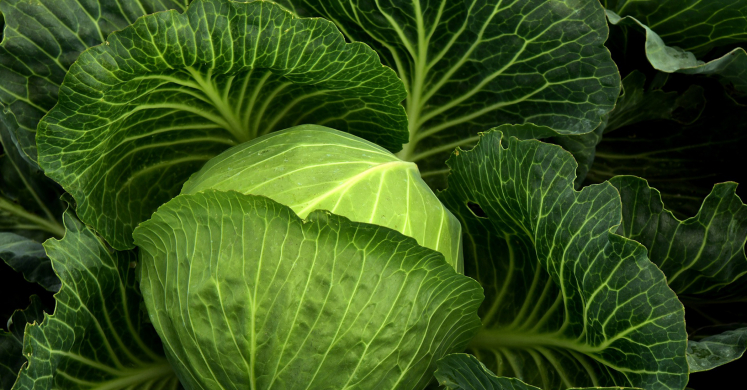Blog

What We’re Cooking With Now: Cabbage
Looking for adventure in the kitchen? Our monthly What We're Cooking with Now post features a fresh produce ingredient, explains how to find the market's finest, and includes a recipe to try at home.
Cabbage
Why: Cabbage is packed with nutrients. Just one cup provides 85% of the recommended daily intake of vitamin K, 54% of vitamin C and 10% of folate. It also contains manganese, vitamin B6, calcium, potassium, and magnesium as well as many other micronutrients. It is also rich in soluble fiber which has been shown to increase beneficial bacteria in the stomach, similar to a probiotic, which aids in digestion and helping to protect the immune system and also reduce bad cholesterol.
Shopping Tip: As with most vegetables, look for brightly colored, vibrant leaves. Avoid any cabbage that has a noticeable odor, discoloration, or soggy leaves. Cabbage can hold for a very long time under refrigeration. With red and green/white cabbage, pick tightly compacted heads that feel heavy. The tighter the better, maybe with a few loose leaves, though you may need to gently pull the outer layer of leaves off to reveal the delicious fresh cabbage inside. Looser, leafy varieties such as napa cabbage, should be firm, not limp, and the stems should snap cleanly rather than feel rubbery when bent.
Preparation: Start by cutting the remainder of the root end off the bottom of the head of cabbage. Whether it is white, green, red, or purple cabbage, it all prepares basically the same. Once you cut the hard root piece off, cut the head in half, through where the root was. Peel off the outer layer of leaves and any other leaves that are discolored. Carefully take a knife and cut a wedge out of the inside of the cabbage where the root end was, to remove the hard part of the root stem and discard. The rest of the head of cabbage is usable. Rinse it well. Most slaws and sauerkraut are made by taking a knife and thinly shredding the cabbage, cutting across the “grain” of the leaves (as thinly as possible).
Recipe: Kimchi
Ingredients:
1 medium head of napa cabbage, sliced thinly
½ head of green/white cabbage, sliced thinly (can also substitute bok choy for green/white cabbage)
½ cup of kosher salt
1 small bunch of scallions, cut into 1/2” pieces
4 heads of garlic minced
5 Tbsp. rice wine vinegar
3 Tbsp. fish sauce (omit to make vegan, or substitute kelp powder)
5 Tbsp. red chili garlic paste (Lee Kum Kee brand, for mild/medium, Sambal Olek brand for hot)
2 Tbsp. dry red chili flakes (optional, for extra spicy!)
Directions:
Take the thinly sliced cabbages and put them in a bowl with just enough water to cover, add the salt, mix well. Let sit for 2 – 3 hours until the cabbage becomes a little bit softer. Drain the water, and rinse the cabbage very thoroughly to remove excess salt.
Mix the garlic, rice vinegar, fish sauce, and chili garlic paste together. Once the cabbage has been drained and rinsed, add the scallions to the cabbage, then pour the spice paste over and mix it very well. Cover with saran wrap and let sit overnight in the fridge. It will be ready to eat the next day but if you let it sit covered, in a jar, it will ferment naturally after 5 – 7 days in the fridge. It develops a pungent, tangy flavor the longer it ferments.
If you choose to ferment (I highly recommend trying it), place the kimchi in a jar with a tightly fitting lid, and press all of the liquid out of the jar. After one day, check the jar, and stir it around, pressing down to release any liquids. Drain off about half the liquid, but keep the cabbage mostly submerged. Check the kimchi every day, and repeat, as more liquid will appear as the moisture is extracted from the cabbage.

